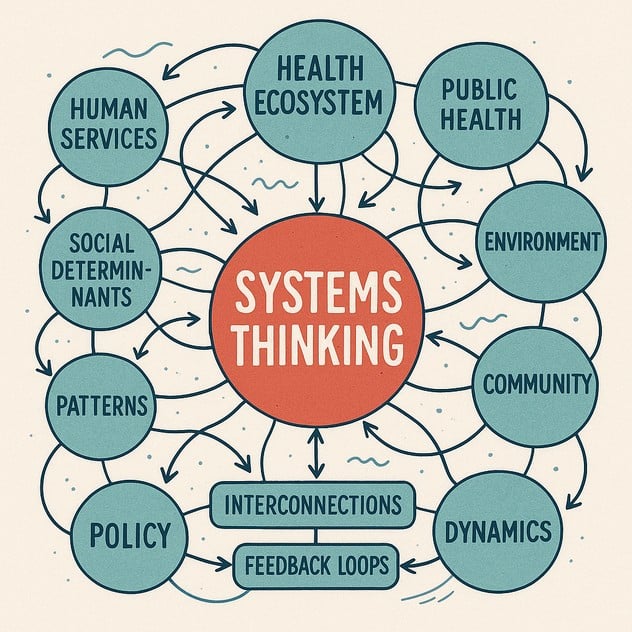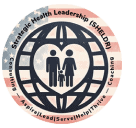Are you leading health and human services like a mechanic patching leaks, or like an architect redesigning the entire system for resilience and impact?

Executive Summary: Ready to move from patching problems to transforming systems? 🚀 15 Essential Systems Thinking Books for Strategic Health Leaders is your launchpad. Rooted in the bold mission of Making All Americans Healthier as a National Strategic Imperative (MAHANSI), this reading list will sharpen your leadership, unlock real change, and teach you how to redesign broken systems—not just manage the chaos. No sector gets left behind in healthcare, public health, and human services. 📚 Start your leadership evolution today. Heal the systems. Lead the future. 🌎✨
Table of Contents
Introduction to the Imperative to MAHANSI through Systems Thinking
If you’re serious about transforming health and human services, you can’t afford to lead with tunnel vision. Today’s healthcare systems are more like living ecosystems than static machines—they pulse, adapt, and evolve. Diagnosing them requires a whole new set of leadership skills rooted in systems thinking. I’ve gathered a roadmap of essential reads that have sharpened my strategic health leadership, and I want to share them with you. You ask why? Let me explain.
We Must Make All Americans Healthier ASAP
Let go beyond the Robert Wood Johnson Foundation (RWJF) “Culture of Health” mandate and start Making All Americans Healthier as a National Strategic Imperative (MAHANSI), ASAP. MAHANSI is a bold call to reframe health (not a petty political talking point), not just as a personal issue, but as a national priority essential to economic strength, social stability, and global competitiveness. In simple terms, MAHANSI treats the health of every American as a vital asset—like clean water, strong defense, or a robust economy—that must be safeguarded and strengthened through intentional strategic health leadership (SHELDR) and systemic action.
The importance of MAHANSI cannot be overstated. Healthier populations drive stronger workforces, lower national debt through reduced healthcare spending, and build more resilient communities ready to weather crises. It shifts the focus from reactive sick care to proactive health creation across all sectors—healthcare, education, housing, business, and beyond. To some, its scary, even a threat. It should be a call to action and opportunity to seize the moment.
However, the challenge lies in breaking free from fragmented, reactive approaches. America’s health ecosystem often operates like a series of disconnected silos rather than an integrated system. Aligning stakeholders, dismantling barriers, and sustaining coordinated efforts require upstream strategic health leadership and systems thinking.
In application, MAHANSI demands that health systems leaders, public health advocates, policymakers, and businesses work together to create upstream solutions—addressing social drivers of health, expanding preventive care, and innovating care delivery. It is the strategic blueprint for building a healthier, more prosperous nation.
If you’re serious about transforming health and human services, you can’t afford to lead with tunnel vision. Today’s healthcare systems are more like living ecosystems than static machines—they pulse, adapt, and evolve. Diagnosing them requires a whole new set of leadership skills rooted in systems thinking.
I’ve gathered a roadmap of essential reads that have sharpened my strategic health leadership, and I want to share them with you. Here they are.
Health Leadership and Development of Systems Thinking Competencies
Let’s start with the health-focused heavy hitters. Systems Thinking for Health Organizations, Leadership, and Policy: Think Globally, Act Locally by James A. Johnson and Douglas E. Anderson is like upgrading your leadership operating system. It teaches you to zoom in and out—from individual patients to global health policies—without losing clarity. Health Systems Thinking: A Primer by James A. Johnson, Douglas E. Anderson, Caren Rossow is the stethoscope you’ll need to diagnose systemic issues, offering clear frameworks and case studies that feel immediately applicable whether you’re redesigning clinical operations or rethinking public health programs.
For those of us looking to change not just systems but lives, Systems Thinking for Social Change by David Peter Stroh is a blueprint for building lasting impact. Stroh shows that throwing more programs at problems often just rearranges the furniture. Instead, we must rewire the house—align stakeholders, unlock feedback loops, and redesign the structure itself.
Foundational, Easy to Read on Systems Thinking
Some books are foundational, like bedrock beneath our hospitals and agencies. Donella Meadows’ Thinking in Systems is a timeless classic that teaches how small interventions can ripple into large change, just like one strategic vaccination program can prevent a whole chain of illnesses down the line. Similarly, Peter Senge’s The Fifth Discipline invites us to build “learning organizations”—vibrant places where health teams can continually adapt and innovate rather than ossify under outdated protocols.
Albert Rutherford’s The Systems Thinker fine-tunes your ability to spot hidden forces, perfect for leaders grappling with why hospital mergers fail or why well-intended policy reforms backfire. Daniel Kim’s Introduction to Systems Thinking serves as your dashboard, helping you monitor the vital signs of any system, from patient flow in emergency departments to statewide mental health initiatives.
And don’t sleep on The Systems Thinker (website), a living library of case studies and practical models. Think of it as your 24/7 systems coach—always ready to sharpen your understanding when you hit a snag or need a new tool for a complex challenge.
Timeless Classics and Systems Thinking
Then we have the timeless classics—the deep wells of insight every serious leader should draw from. Kenneth Boulding’s General Systems Theory – A Skeleton of Science reminds us that all disciplines—biology, management, public health—share common structural DNA. Jay Forrester’s Industrial Dynamics teaches why quick fixes often produce the opposite of what we intend, a lesson every health administrator confronting rising costs can appreciate.
Stafford Beer’s Cybernetics and Management is an essential guide for building adaptive, self-regulating organizations—a must in today’s volatile healthcare landscape where new pandemics and technologies emerge overnight. Ludwig von Bertalanffy’s General Systems Theory provides the master blueprint for interconnected thinking, while C. West Churchman’s The Systems Approach offers a sobering reminder: every “solution” creates new risks. Whether you’re redesigning Medicaid funding or rolling out a new electronic health record, it’s a lesson that rings true.
Gregory Bateson’s Steps to an Ecology of Mind challenges us to view health systems as deeply interconnected with culture, education, and environment. His work invites us to move beyond linear cause-and-effect models to something richer and more holistic. Russell Ackoff’s Redesigning the Future urges us to move from piecemeal fixes to total system redesign—critical advice if we want to move beyond tweaking our healthcare system to truly healing it.
Summary
Each of these works has, at different points, acted like a defibrillator to my thinking—jolting me out of simplistic views and into a deeper, more transformational mindset. They have helped me build better systems, lead stronger teams, and ultimately serve communities more effectively.
If you want to be more than a manager of broken parts—if you want to be a healer of systems—start your systems thinking journey today. Pick up one of these books. Apply their lessons. And watch as you begin not just to navigate complexity, but to reshape it for the better.
Learn more at https://Sheldr.com
5 Exciting System of Systems (SoS) Concepts to Improve Your Strategic Health Leadership Competencies
Reading Roadmap: Essential Systems Thinking Books for Strategic Health Leaders
Health and Human Services Focused
Systems Thinking for Health Organizations, Leadership, and Policy: Think Globally, Act Locally, James A. Johnson & Douglas E. Anderson (2018) 📈 Your go-to guide for applying systems thinking directly to health leadership. Packed with tools and cases, it’s like upgrading your leadership operating system across clinical, policy, and global levels.
Health Systems Thinking: A Primer, Johnson, Anderson, & Rossow (2017) 🔢 A must-read starter kit. This concise book is the stethoscope you need to start diagnosing and solving systemic health challenges with clarity and skill.
Systems Thinking for Social Change, David Peter Stroh (2025) 🌱 Your blueprint for redesigning broken systems and avoiding unintended consequences. Perfect for health and social leaders looking to create lasting, systemic impact.
Foundational Easy Reads
Thinking In Systems: A Primer, Donella Meadows (2008) 🔄 The timeless classic. Meadows shows how even small interventions can spark big waves of change. Essential for anyone leading community health, hospital reform, or public policy.
The Fifth Discipline: The Art and Practice of the Learning Organization (, Peter Senge (2006) 💡Learn how to turn your organization into a true learning organization. Essential for leaders who want to nurture innovation, resilience, and sustainable growth.
The Systems Thinker: Essential Thinking Skills For Solving Problems, Managing Chaos, and Creating Lasting Solutions in a Complex World (The Systems Thinker Series), Albert Rutherford (2023) 🌀Learn to spot hidden patterns and forces shaping healthcare, education, and politics. This book sharpens your “systems vision” and gives you better solutions to today’s complex problems.
Introduction to Systems Thinking, Daniel Kim 🌐 A clear, practical overview. Think of it as a health monitor for any system you lead, helping you recognize feedback loops, bottlenecks, and opportunities before they escalate.
The Systems Thinker (Website Collection), “The Systems Thinker” Site 📅 A living library of lessons, case studies, and practical models across health, education, and social sectors. Think of it as your 24/7 systems coach.
Timeless Classics
General Systems Theory – A Skeleton of Science, Kenneth Boulding (1956) 🔬 Boulding’s grand vision for a unifying framework across disciplines—perfect for strategic leaders needing to connect biology, policy, and management.
Industrial Dynamics, Jay Wright Forrester (1961) 💡 Understand the deep structures that drive corporate and healthcare behavior over time. Essential for diagnosing why good intentions often fail without systemic insight.
Cybernetics and Management, Stafford Beer (1967) 🚀 Master the art of adaptive, self-regulating organizations—critical for designing resilient health systems ready for 21st-century challenges.
General Systems Theory: Foundations, Development, and Applications, Ludwig von Bertalanffy (1968) 🔄 The original blueprint for thinking in systems. A must for leaders ready to tackle interconnected challenges in health and human services.
The Systems Approach, C. West Churchman (1968) 🛍️ A critical reminder that every system fix carries risks—and that thoughtful, ethical leadership is vital in a complex world.
Steps to an Ecology of Mind, Gregory Bateson (1972) 🌿Embrace a truly holistic view of health, culture, and community. Bateson challenges linear thinking and invites a deeper understanding of complex relationships.
Redesigning the Future: A Systems Approach to Societal Problems, Russell L. Ackoff (1974) 💪 Go beyond quick fixes—Ackoff shows how true system redesign can transform healthcare, education, and social outcomes at their roots.
Start your systems thinking journey today. Strengthen your leadership. Heal the systems you serve. ✨
#SystemsThinking
#HealthLeadership
#TransformHealth
#MAHANSI
#StrategicLeadership




